The winner – ConvertKit
Not great not terrible
In this comparison, ConvertKit wins seven out of eleven rounds. Three rounds end in a tie, and there is only one aspect where Flodesk outperforms ConvertKit. Carry on reading and learn how these two platforms compare with each other.
What ConvertKit features are better than Flodesk?
- Feature-packed email builder
- Robust automation
- Segmentation
- Granular tracking of subscriber data and behaviour
- 120+ native integrations with different platforms and tools
- Not as seamless email building experience
- Basic automation features
- Lacks common segmentation criteria
- Basic email list metrics
- Direct integration options only for Shopify and Instagram
When it comes to email marketing tools for creators, educators, or small business owners, two choices frequently come to the forefront: Flodesk and ConvertKit. Flodesk is a newer kid on the block, officially launched in 2021, while ConvertKit is an established software that’s been in the game for over a decade now.
Which platform is best for you—Flodesk or ConvertKit? In this in-depth Flodesk vs ConvertKit review, we’ll compare and contrast these two email marketing platforms, unpicking their key differences, features, pros, cons, and pricing plans.
Flodesk vs ConvertKit: A quick overview
Flodesk users appreciate the platform’s modern-looking templates, advanced builder, and easy-to-use interface. Business owners with a larger subscriber base would especially favor Flodesk due to its flat-rate pricing model.
On the other hand, ConvertKit users seem to appreciate the platform’s advanced email marketing features, free pricing plans, and 24/7 customer support.
In the comparison table below, we’ve briefly examined the key features of ConvertKit and Flodesk to help you choose the best one for you:
Flodesk vs ConvertKit: Feature by feature
In this section, we’ll comprehensively compare Flodesk and Convertkit feature by feature to help you decide which email platform works best for you.
Let’s get started.
Ease of getting started

Flodesk set up
Starting with Flodesk is easy. The platform doesn’t offer guidance, such as a getting started wizard. You’re free to decide when and where you’ll start using it.
The platform’s interface is clean and minimal, so you won’t get lost in features.

ConvertKit set up
For ConvertKit, beginners may experience a learning curve when navigating the platform, especially in the initial stages.
That’s because ConvertKit’s menu looks slightly different from what we’re used to seeing on other email marketing platforms. However, with a bit of familiarization, everything becomes clear.
A unique feature of ConvertKit is a Tip Jar that you can set up and send to your subscribers. You can also sell digital products. There’s also a creator network feature that can help you discover and collaborate with other creators.
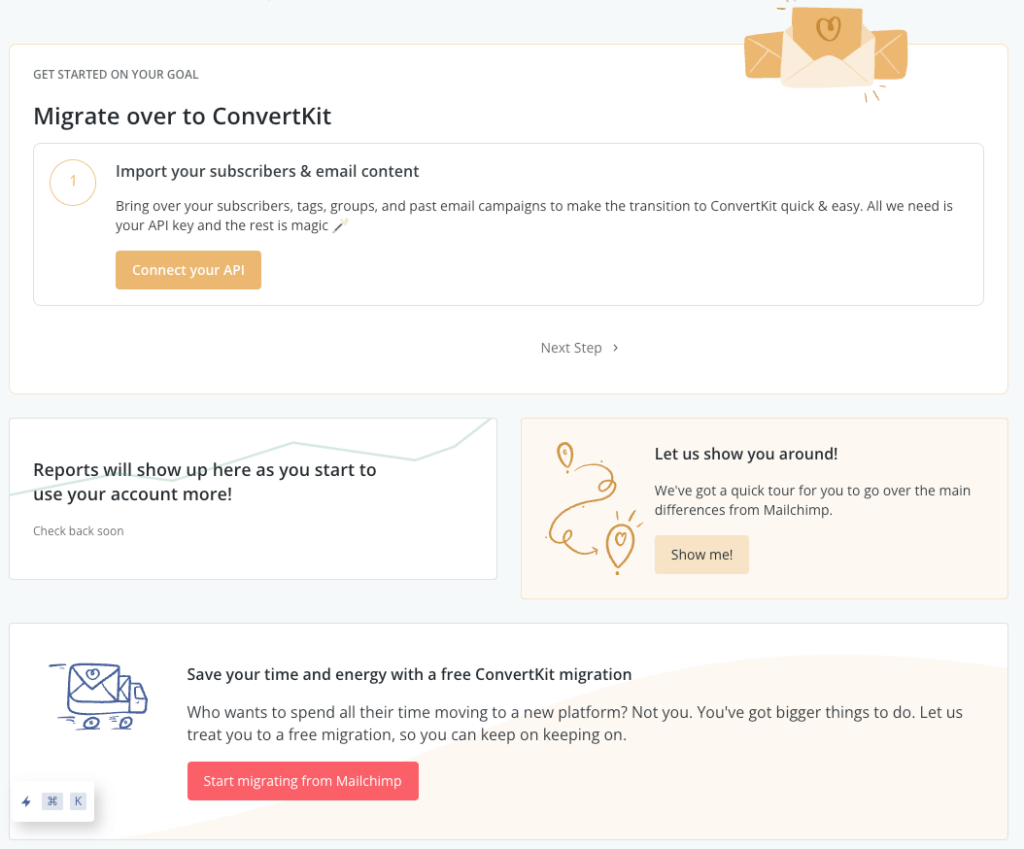
ConvertKit set up
ConvertKit’s settings are user-friendly. You can easily change your initial information, add a new sender email address, find billing information, and many more.
Flodesk takes the lead on this one. It features a user-friendly interface that even a beginner may not need guidance to navigate.
Building an email campaign
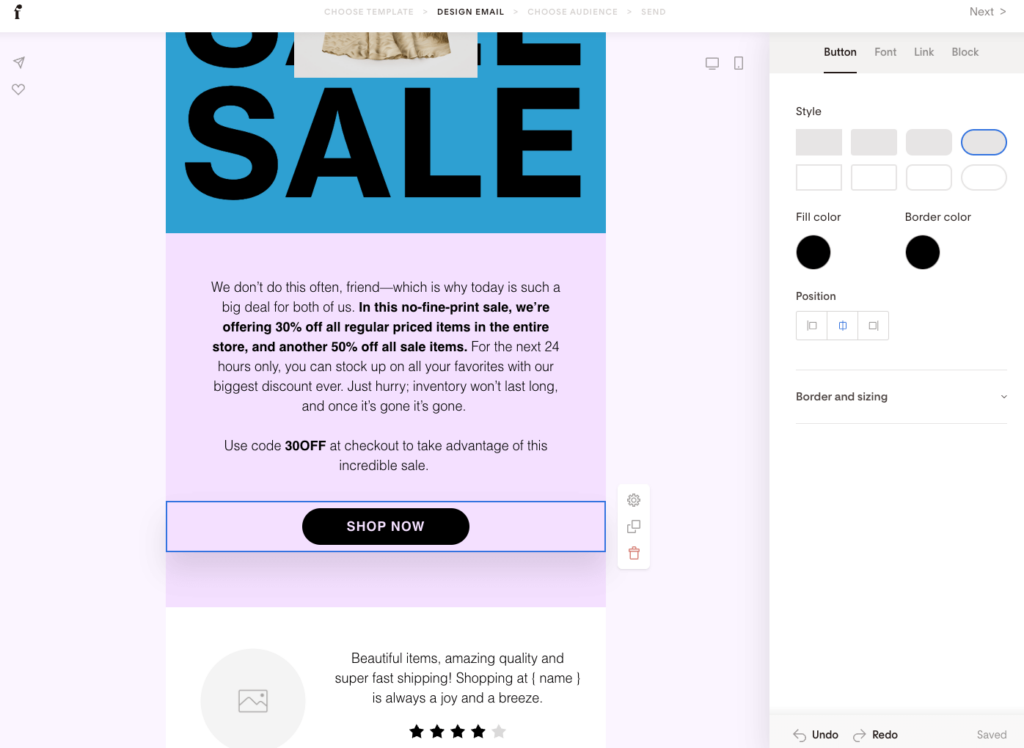
Flodesk email editor
Flodesk’s email-building wizard is well-organized and user-friendly. It features all the essential elements for email building, such as images, menus, lines, and social media elements.
It guides you through a simple email creation process. Choose a template, edit the design, and then add your campaign details. This may include the subject line, recipient’s name, and sending time.

ConvertKit email editor
ConvertKit, on the other hand, has an intuitive and well-organized email builder that allows advanced features like A/B testing and email campaign automation.
It’s more feature-packed than Flodesk’s email builder. However, it’s not a drag-and-drop builder, so building an email may not be as seamless as Flodesk.

Flodesk email editor
When it comes to templates, Flodesk’s pre-built templates are truly the highlight of the platform.
ConvertKit is limited in templates, as it offers only 15 pre-built templates. Meanwhile, Flodesk’s multiple templates look professionally designed, are visually stunning, and have a modern feel.
However, Flodesk needs advanced features like A/B testing, auto-resending, and sending automated letters to subscribers. This may be a challenge as your business continues to grow.
ConvertKit takes the lead on this one, as it offers more than Flodesk regarding email building.
Marketing automation
Flodesk vs ConvertKit—which email platform offers better marketing automation?
Both platforms seem to have the same email marketing automation features, but ConvertKit has the upper edge.

Flodesk automation
Flodesk’s basic automation feature would only be ideal for basic email marketing and digital sales needs.

ConvertKit automation
On the other hand, ConvertKit’s automation is more robust, with its navigation divided between “sequences” and “automations.”
It also offers many built-in triggers based on actions or events. Meanwhile, Flodesk has only one trigger so far, which is activated when subscribers enter a segment.
Also, ConvertKit has 28 pre-built automation templates, while Flodesk only offers four pre-built workflows. And with Flodesk, you can create your email from scratch.
When it comes to integrations, ConvertKit and Flodesk offer email only.
ConvertKit wins this one. It outshines Flodesk in almost every aspect regarding marketing automation.
Signup forms and landing pages
Let’s now look at Flodesk vs ConvertKit when it comes to their list-building capacity.
Both email marketing platforms offer signup forms and landing pages.
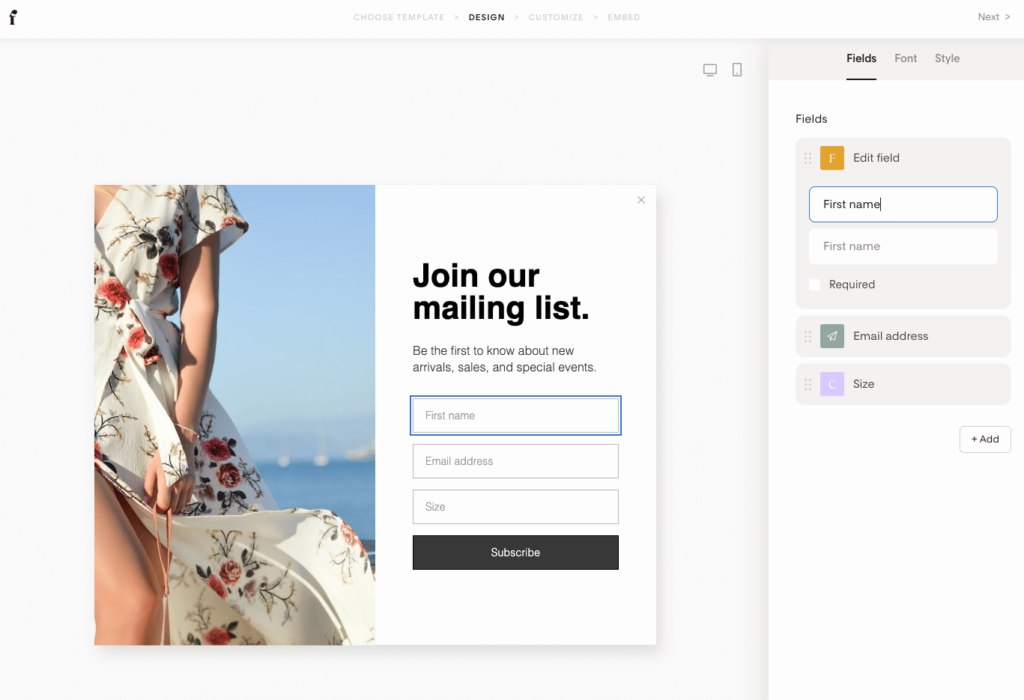
Flodesk signup form builder
Flodesk offers good functionality for signup forms. The platform boasts 30+ modern, highly customizable templates for signup forms. You can create a popup, inline, or full landing page form.
The best part is that after your subscribers sign up, you can display a thank-you note or direct them to a landing page of your choice.
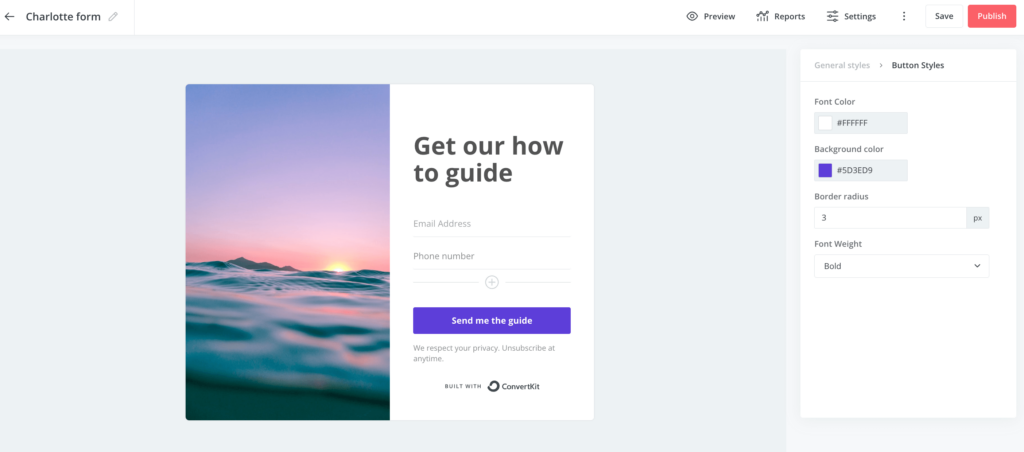
ConvertKit signup form builder
ConvertKit, on the other hand, is a bit limited when it comes to signup form templates, as it only has a library of nine templates.
However, for landing pages, ConvertKit has 50+ templates for webinars, events, waitlists, ebooks, newsletter collection, podcasts, and many other creative platforms.
While limited in number, Flodesk’s landing page templates are just as good. Its templates are tailored for specific purposes, such as education, services, or selling digital products.
Even so, users should be aware that Flodesk refers to its landing pages as “checkouts.”
Additionally, Flodesk’s popup settings are a bit limited.
As for ConvertKit, it needs direct form publishing to your website, just like Flodesk. You have to do everything manually. The platform also lacks advanced form features like A/B testing and multistep popup.
It’s a tie for this. Both platforms offer different features that are valuable in equal measure.
Segmentation
Flodesk or ConvertKit: Which email platform has better segmentation capabilities?
Both tools offer basic segmentation capabilities.
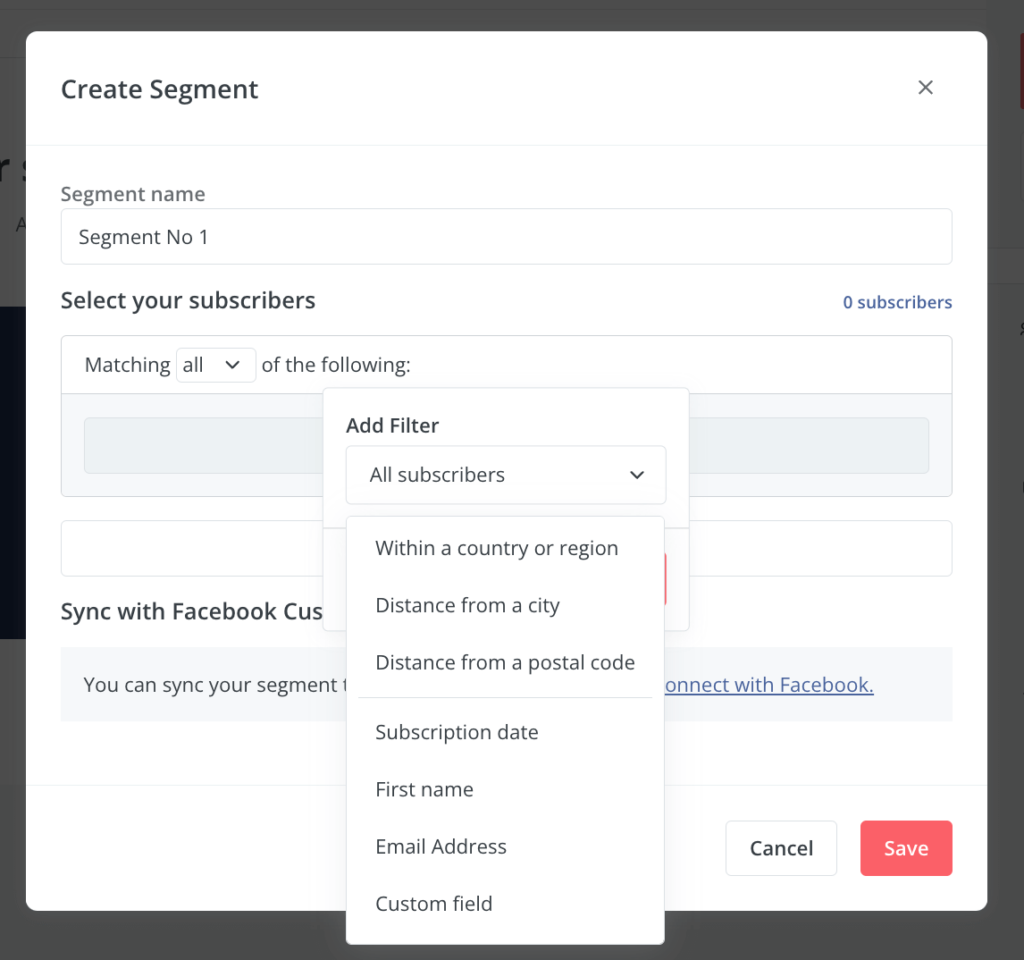
ConvertKit segmentation
With ConvertKit, you can segment your subscribers based on criteria such as:
- Date of subscription
- Name
- Location (city, country, and postal code)
You can manually assign or apply segments using visual automation and rules.
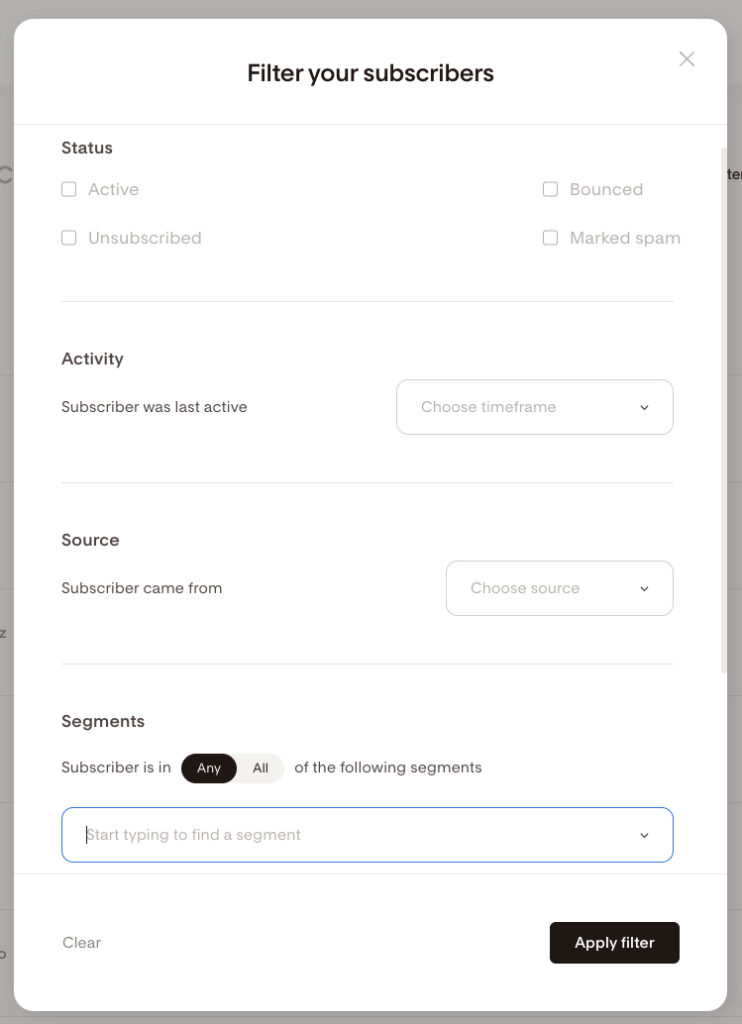
Flodesk segmentation
In Flodesk, while it provides an opportunity for you to tag your subscribers, we couldn’t locate this function during our evaluation.
Its segment conception also seemed quite different from other email platforms.
Instead of common lists, you have segments that can only be created by filtering. You can filter by activity date and status, source, belonging to other segments, and belonging to other data fields.
For ConvertKit, the only major limitation is that it lacks advanced filters. It relies more on its tag functionality to add segments.
Meanwhile, Flodesk lacks common segmentation criteria like email activity and demographics, making it a bit difficult to maneuver.
Although the tags seem to extend its segmentation capabilities further, they can be challenging to manage and may not effectively capture your subscribers’ preferences and actions.
ConvertKit wins this round.
Analytics
One of ConvertKit’s greatest strengths is its robust analytics and granular tracking of subscriber data and behavior.
When you log in to the email platform, you’re immediately directed to a dashboard showing the statistics for each email you send. This includes open rates, click rates, and unsubscribe rates.
You can also see your total number of subscribers, top-performing forms, and a list of your new subscribers.
Flodesk, however, provides only the basic email and list metrics without any detailed segmentation.
The platform’s analytics can generally be divided into three segments:
- Automation: Number of active subscribers, entries, completions, open rates, click rates, and unsubscribe rates
- Email campaigns: Insights on email engagement, clicks, opens by device
- Checkouts: Number of visitors, orders, and total sales
While Flodesk provides essential email campaign insights, it falls short when it comes to predictive analytics.
However, ConvertKit also doesn’t offer this kind of analytics.
ConvertKit is the winner. We feel that it’s a more complete tool with more features developed.
Customer support
Flodesk provides unique customer support. There’s no phone or chat support available, only email support from 6 a.m. to 6 p.m. EST.
ConvertKit, on the contrary, provides 24/7 live chat and email support for paying customers. For free users, the platform offers community support only.
Regarding responsiveness, we found ConvertKit’s support to be pretty fast. They got back to us in less than three minutes when we contacted them.
Both platforms provide useful resources, support channels, and tutorials where you can find expert help with troubleshooting issues.
These channels include Flodesk University and help center articles for Flodesk and the ConvertKit community forum and Creator university for ConvertKit.
ConvertKit takes the lead. It not only offers multichannel, 24/7 support, but it also has a range of learning resources.
Integrations
ConvertKit offers 120+ native integrations with different platforms and tools, including Squarespace Commerce and Shopify. Integrations that aren’t native to the platform can be added through Zapier.
Flodesk, on the other hand, needs integration with ecommerce platforms like Wix and OpenCart. At the moment, the email platform only offers direct integration options for Shopify and Instagram.
Flodesk’s limited native integration can be seen as a challenge, especially if you run an ecommerce store. The good news is that Flodesk allows Zapier integration, so you can Install Zapier and add more integrations as necessary.
ConvertKit wins in this round due to its wide range of native integrations.
Compatibility with other marketing channels
When an email platform is compatible with other marketing channels, your chances of reaching a wider audience are increased.
For Flodesk and ConvertKit, integrations with other marketing channels are pretty limited.
For instance, ConvertKit only offers email marketing, unlike other platforms like Omnisend, which combine email, SMS, and push notifications in one flow.
However, you can still integrate SMS and push notifications into your marketing campaign using a third-party service.
Fortunately, ConvertKit is compatible with Facebook custom audiences. This can help you reach more potential customers on the platform.
Currently, Flodesk isn’t compatible with any marketing channel.
ConvertKit is a clear winner in this round. Even though it’s only compatible with Facebook, it’s a far better option than what Flodesk provides.
Generative AI tools
Currently, neither Flodesk nor ConvertKit has any AI tools for email or form creation. The verdict is, therefore, a draw for this round.
Price Comparison
In this section, we’ll compare Flodesk vs ConvertKit’s pricing models side by side to see which solution fits your budget.
Free plans comparison
ConvertKit offers a free plan that allows up to 1,000 subscribers. On the contrary, Flodesk doesn’t have a free plan. Instead, it offers a generous 30-day free trial that allows you to test its features before committing to a monthly plan.
Paid plan comparison
Flodesk or ConvertKit: Which platform provides value for your money? Well, you’re about to find out as we explore the pricing plans of Flodesk and ConvertKit.
Flodesk takes a unique approach with a fixed flat-rate pricing plan for its two paid plans: Email and Email & Checkout. With this type of pricing plan, you’re charged a fixed subscription fee, with access to all features regardless of the number of subscribers you have or your usage level.
On the other hand, ConvertKit offers two paid pricing plans: Creator and Creator Pro. The prices for these plans depend on the number of subscribers and features you need.
Below is a side-by-side comparison of Flodesk and ConvertKit’s monthly pricing plans:
Flodesk’s two paid plans cater to different business needs. While the Email plan mainly focuses on email marketing needs, the Email & Checkout plan is designed to fulfill both email and ecommerce marketing needs.
ConvertKit’s Creator plan starts at $29 a month, which can be a much more affordable option for smaller businesses or creators with less than 1,000 subscribers.
However, for larger businesses, Flodesk may be a more cost-effective option since it maintains consistent prices regardless of the number of subscribers you have. The only question is whether this tool is sufficient for bigger businesses.
Meanwhile, ConvertKit, like most email platforms, increases its pricing based on your subscriber count. The more your subscriber count grows, the more you have to pay.
Flodesk vs ConvertKit: Which one wins?
Before we announce the ultimate winner for this Flodesk vs ConvertKit review, let’s briefly recap the features and pricing of both email marketing platforms:
3.1
3.8
Email plan – $38/month
Checkout plan – $38/month
Everything plan – $64/month
500 subscribers – $29
1,000 subscribers – $29
5,000 subscribers – $79
10,000 subscribers – $119
50,000 subscribers – $379
100,000 subscribers – $679
- 30-day trial
- Up to 1,000 subscribers
- Unlimited landing pages
- Unlimited forms
- Unlimited broadcasts
- Audience tagging and segmentation
- Selling digital products & subscriptions
- Community support
- Free recommendations
- Beautiful designs
- Very easy to use
- Lots of features for creators
- Templates and automations tailored for creators
- Great support
- Basic automation and segmentation features
- No live chat support
- No direct integrations
- Unusual interface
- No AI tools
- Email marketing channel only
- Bloggers
- Freelancers
- Educators
- Personal branding specialists
- Nonprofit organizations
- Digital sellers
- Online creators like bloggers, freelancers, and educators
- Ecommerce businesses
- Ecommerce brands
They can cater to the needs of bloggers, creators, educators, or small online businesses (selling digital products).
However, for businesses looking for robust email and SMS marketing functionalities for ecommerce, Omnisend is the most excellent choice. It provides an impressive range of functionalities to help boost customer engagement and sales.
Read full reviews
Related picks for you
Our team strives to be accurate and unbiased in reviewing email tools. However, we recognize that mistakes can happen, and it’s essential for us to stay up to date. If you come across any errors or things that need to be reviewed again, please let us know.




